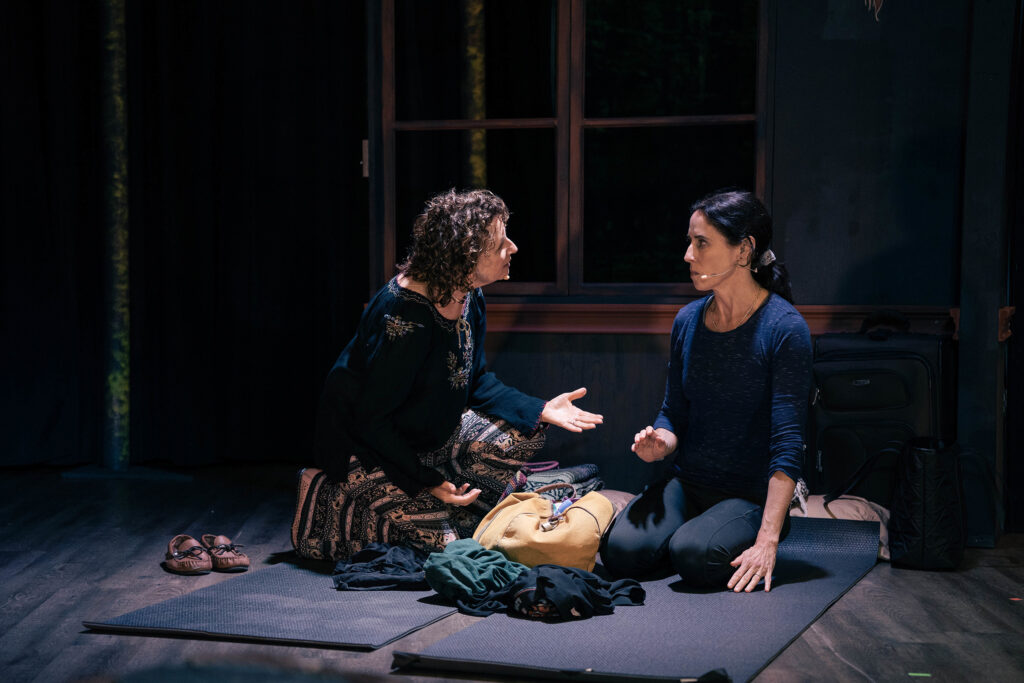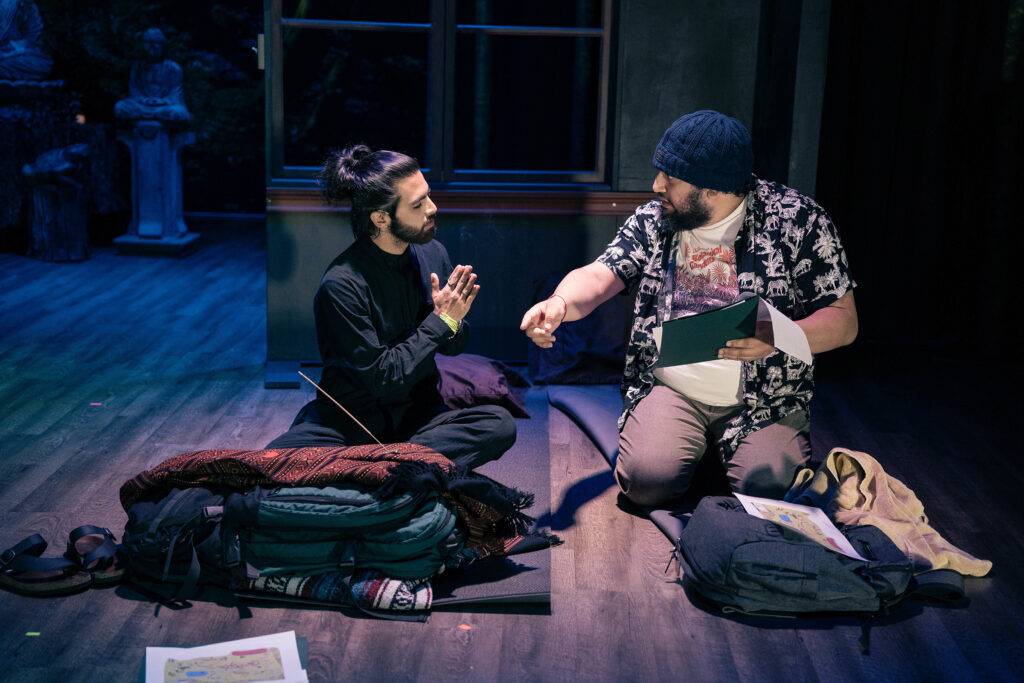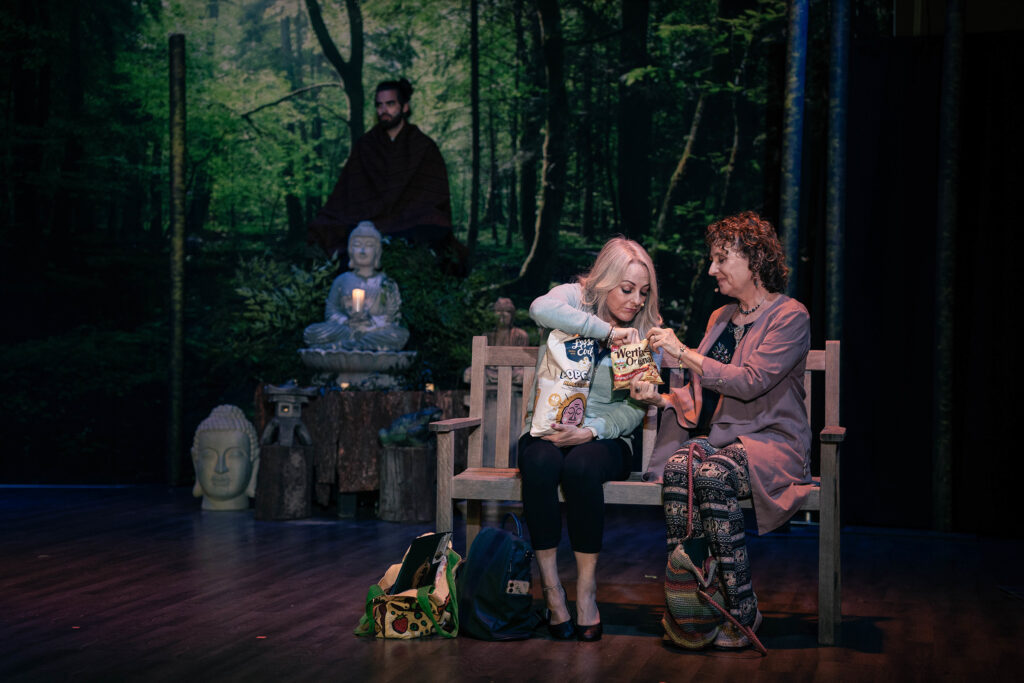An Independent Review of Small Mouth Sounds
By John Henry Martin

You’ve probably heard of this new age, hippy dippy thing that many people, overwhelmed with today’s hectic pace of life, are doing: a silent retreat. This is where you go to a retreat center for a few days or even a week, and do not speak to anyone the entire time. The idea behind this practice is to eliminate things that are distracting you in your daily life, so that you can deal with what is going on inside your head. In this way, you purify your thoughts and reenter the world a more calm and peaceful person.
Well, in Valley Players’ latest production, Bess Wohl’s “Small Mouth Sounds,” a silent retreat with six participants and a retreat leader – who’s a disorganized ego maniac – go through all the drama of an existential crisis – and come out enlightened, but not in the way they all expected. (It never happens the way you expect anyway.)
There, however, is one little hitch – this is a silent retreat. That means no talking. And yet, this is theater, the very nature of which requires talking. How is one to create a play for a drama to unfold when all the characters must remain speechless? This is why I love Valley Players. They never shy away from a challenge.
What ends up happening is that, for nearly the entire play, the actors end up pantomiming their characters, enhancing their actions with, what academics refer to as, “nonlinguistic emotive vocalizations.” These are sounds the actors make with their mouths that add emotion and direction to the message they are trying to convey. But the sounds are not words.

A word about terminology: nonlinguistic is different than non-verbal. Nonlinguistic sounds are those made using the human voice, but the sound does not correlate with a word. Whereas something that is nonverbal, like a cue, is a physical thing that someone does to send a message which does not use the voice at all – like a facial expression or a hand gesture.
Telling a story without words – only using nonlinguistic sounds and nonverbal movements – is a fairly common game that students play in acting classes. It prevents the actor from depending on the meaning of the word to convey the message and forces them to use their entire body to get their point across. In this way, it was a huge challenge for the actors – one that they were able to execute pretty successfully.
And that is where the rather bizarre title of the play comes from. Wohl calls these “Small Mouth Sounds.”
Now, the whole point of a play like this is for many unrelated people to come together and clash with one another. It is therefore important that many types of people be represented. But how can I identify them when hardly anybody spoke, and the only times their names were used were in the program? I’ll have to use my powers of deduction to determine who was who.
I know who Jan is, because he is played by Valley Players regular Richard Pallaziol. He is an older-than-middle-aged man, a bit dowdy, but cheerful and ready to be enlightened.

Judy and Joan – I have no way of telling apart – are played by Amy Hall and Linda Howard. I think they were a lesbian couple. They come in arguing about who gave who what directions. Everyone else is silent and their argument is especially piercing. Their relationship seems to be on the rocks.
I know that Bridget Folan played Alicia because Bridget has been in many other Valley Players productions, particularly a starring role in The Tin Woman a few years back. She is beautiful and blond, and enters late with headphones on, unaware that Taylor Swift is blaring from her iPhone.
That leaves Ned and Rodney, played by either Fernando Espinoza or Luis Marks. One of them is an authoritative yogi who brings his own prayer shawl and plants himself on the floor, effortlessly in full lotus while everyone else sits uncomfortably in folding chairs. The other one is an overly insecure guy very much afraid of offending everyone or violating any unspoken rules about being on a silent retreat.
(Right after writing that, I got an email from June Reif and Debbie Baumann, two of the mistresses behind Valley Players, who confirmed for me that Ned was the insecure guy, played by Fernando Espinoza and Rodney was the yogi, played by Luis Marks.)
And then there is Bonnie Gamble who plays the Teacher. She is unseen for the entire play, addressing the six supplicants in a booming voice, like a God. Except, this teacher is the least peaceful, the least insightful or enlightened person anyone would want to lead a retreat. All of the participants cringe at her opening parable about a frog who lives at the bottom of the well and is coerced into going to see the ocean by another frog. Then upon seeing the ocean, the first frog unceremoniously dies. The teacher chuckles as she relates this and the participants’ eyes go wide with bewilderment, incredulous that they are going to be led by someone so…weird. And that is when you know this play will be a satire.
It is a satire because silent retreats are supposed to be peaceful, but this one is not. There is skinny dipping in a lake, a ferocious bear, pot smoking, and a heartbreaking misunderstanding that leads to the end of a relationship. And that is not to mention Ned’s incredible monologue where he talks about how his skull was fractured in six places in a rock-climbing accident, his wife left him for his brother while he was in the hospital, his identity was stolen, his house burned down, his credit rating was ruined by the identity thieves and he had no money to rebuild. Espinoza’s performance was extremely touching and funny at the same time.

Though I have to say, by the time intermission rolled around, the characters’ silence felt like a gimmick that started to get old. I got impatient because it felt like the actors were using crutches when their legs were just fine.
Also, usually, in most silent retreats, the facilitators do their best to limit your interactions with the other participants. In this one, however, everyone seems to be all over one another.
What the play does get right about silent retreats, though, is what happens at the end. While there was a whole lot of drama, the characters come away changed, for the better, as people usually do. And this is memorialized in a ceremony in the last scene where they burn a piece of paper on which they wrote their intentions at the beginning of the retreat.
The end also included a small surprise about Jan, which was one of the most brilliant plot twists I have seen in a long time. It took advantage of the fact that you never heard Jan speak a word the entire play.
But, when the play ended, I reflected on all the things that happened. Especially how extremely different the six participants in the retreat were – which created moments that were hilarious, terrifying, depressing, clever and poignant. The play seemed to have every emotion that a drama could offer. And it was all tied together with the bonhomie everyone feels when they share an experience – or a tribulation. So, I felt like I got the benefits of the silent retreat, the same way the characters in this play did. Except, my vow of silence was limited to two hours as an audience member. I don’t know if I could handle two days.
